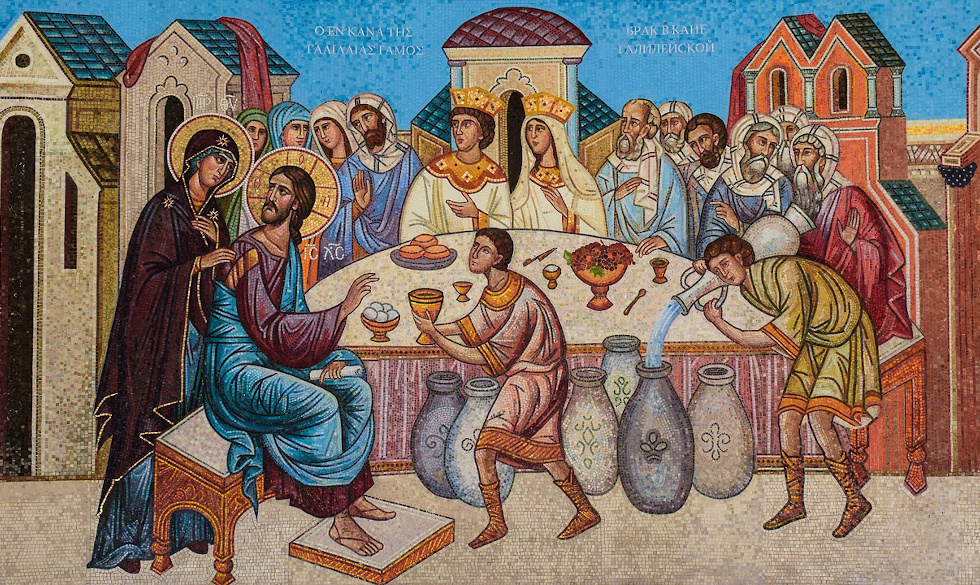I would like to explore the nature of a sacrament and use the Sacrament of Marriage as a working example.
In the Catholic tradition, marriage is seen as one of the seven sacraments, but in some other traditions marriage is seen, only in procreative and social terms.
What are the ingredients of a sacrament and how are they combined prior to being baked in the "theological oven”?
The sacramental ingredients are image, likeness and grace. To procure some ideas on image and likeness a good place to look would be Genesis 1:26, "And God said, let us make man in our image after our likeness".
For a lot of people image and likeness are just synonyms, but there is a subtle difference between them. Consider the following: Suzie is the spitting image of her grandmother, but she behaves like her aunt Maude. To the person observing Suzie, before Suzie says or does anything, Suzie unconsciously images her grandmother in her primary attributes - say her body type, facial features, body language. She and her granny share the same inbuilt characteristics. When you see Suzie, you are essentially looking at a version of her grandmother. As soon as Suzie starts to interact with people though, she behaves like her overly gregarious aunt Maude. She has her grandmother's hardware, but she is running her Aunt Maude's software.
Now something could happen in Suzie’s life. She could get married, there could be some joyous thing, some tragic thing, some epiphany that moves her away from the brash aunt Maude persona and she adopts the quiet and more thoughtful behaviours of her grandmother. She can move her operating system from Windows to Linux. Salvation is indeed possible! From this example, we can say that image has to do with being and likeness has to do with behaviour.
In theological terms, Thomas Aquinas makes a similar distinction between image and likeness. For him, image has to do with the shared nature of the “imager” and the” imagee”, whereas likeness is a moral or behavioural category. For Aquinas, human beings were created good, but with the fall, sin corrupted their moral likeness to God and perverted their will. As humans, we now suffer from a malware infection: sin, whose malicious intent is to cause a system crash, or our death. Aquinas points out that fallen man needs supernatural grace from God so that his moral likeness may be restored, and the sacraments are the delivery mechanism for that supernatural grace.
 We now have grace, our third ingredient. Our sacrament is now ready for the oven.
We now have grace, our third ingredient. Our sacrament is now ready for the oven.
There is a practical aspect to this differentiation between image and likeness. They give a binocular vision of the person. What I mean by that is, you have two eyes, so you are able to see depth. If you cover up one eye or if you must put on an eye shield, you become monocular. In that state, it becomes difficult to drive your car because everything gets flattened out - you don't see depth; you don't see nuance. The sacramental perspective gives a binocular as opposed to a flattened monocular view of the person.
From a sacramental perspective then, every person has an innate dignity because of their imageness but need salvation because of their tarnished likeness.
In going into the scriptures for a confirmation of this distinction, consider the following: When Jesus says "He who has seen me has seen the Father", Jesus is imaging the Father, and when Jesus says "For I have come down from heaven, not to do my own will, but the will of him who sent me." he is engaging in behaviours, towards us, that present the likeness of the Father (John 14:9 and John 6:38 respectively). With those two scriptures hopefully, you can see where Jesus is the icon of the perfect harmonic blend of image and likeness. He presents a counter point to our disharmony which, as per C. S. Lewis, manifests itself as deep personal longing for wholeness or authenticity. Another way of saying it could be that we have a God shaped hole in our heart. There is something within us that is not quite 100%.
In His passion, when Jesus says, "Forgive them for they know not what they do." (Luke 23:34) the persons in the crowd are worth forgiving because of the nature of their image, even though their behaviour is evil. This nuanced binocular sense of image and likeness, is the ground for forgiveness. As an aside, the existential crisis brought on by Christ's forgiveness may move us to seek a "software upgrade". Think of Saul becoming Paul on the road to Damascus. Forgiveness can be a means of grace.
At the non-sacramental end of the pipe, there are theologies, in the marketplace of ideas, that the church has declared heretical. For example, according to Jansenism and Calvinism our image and likeness have both been damaged so we are in a state of total depravity. In these schemas, the tendency is to see us as monocular rather than binocular. This has ramifications for the quality of our interpersonal relationships.
Take as an example, from outside the church; the current social justice warrior, woke, and cancel culture. It adopts an extremely secularized version of total depravity. In the “woke” world, it is possible to be truly “bad to the bone”. In this woke society, a tweet that you made years ago, can be used to show that you are not sufficiently "woke". With your twittering behaviour you have personally offended the great social justice warrior god and that offence requires an extreme response, you can be sent out into utter darkness - for example lose your job. In the secular religion of "wokeism" the sinner and their social sin are bound tightly together. In that monocular vision, you and your behaviour are one, so your punishment is a moral necessity; forgiveness is never an option. A deep personal relationship in that society would be difficult because if some sin is uncovered, you become, by default, persona non grata, and you are righteously taken out and burned at the digital stake.
Back to the notion of a sacrament. From the Catechism of the Catholic Church, paragraph 1131 states: "Sacraments are efficacious signs of grace instituted by Christ and entrusted to the Church by which divine life is dispensed to us."
Since we started with the creation story in Genesis, that narrative also speaks of man being made from the dust of the earth and God breathing life into him. Consider your cell phone: the circuit board and the metal oxide semiconductors etc. are literally the dust of the earth. It is only when an electric current is applied that those components become a functioning circuit that can generate and receive modulated electromagnetic waves and talk to other cell phones. I would like to use to this concept as a metaphor for a sacrament.
 If you wanted to charge your cell phone, because it needs an electric charge to come functionally alive, one possible approach, is that you could climb up to one of the high tension distribution towers to try and charge up your cell phone, but at 765,000 volts and 1000 amps, when you got up to the wires you're not going to charge your cell phone because you and your cell phone are just going to fry. You will be electrocuted; you will become a greasy spot floating to the earth. Both you and your phone would be destroyed. As an aside, in the choirs of angels schema, the seraphim, who are the closest angels to God, are constantly on fire, they are like charcoal briquettes with wings, just glowing all the time. The electrical substation delivery network steps down the high transmission voltage to the 110 volts that comes in your house, and then your cell phone charger brings that 110 volts down to 5 volts at 1.1 amps - the perfect voltage to charge your phone. Sacraments deliver the power of God's grace, which would be just overwhelming in its full power, to us at the optimum human infused service voltage.
If you wanted to charge your cell phone, because it needs an electric charge to come functionally alive, one possible approach, is that you could climb up to one of the high tension distribution towers to try and charge up your cell phone, but at 765,000 volts and 1000 amps, when you got up to the wires you're not going to charge your cell phone because you and your cell phone are just going to fry. You will be electrocuted; you will become a greasy spot floating to the earth. Both you and your phone would be destroyed. As an aside, in the choirs of angels schema, the seraphim, who are the closest angels to God, are constantly on fire, they are like charcoal briquettes with wings, just glowing all the time. The electrical substation delivery network steps down the high transmission voltage to the 110 volts that comes in your house, and then your cell phone charger brings that 110 volts down to 5 volts at 1.1 amps - the perfect voltage to charge your phone. Sacraments deliver the power of God's grace, which would be just overwhelming in its full power, to us at the optimum human infused service voltage.
To close I'll give a quote from a sacramental marriage definition from one of the marriage web sites: "In a sacramental marriage God's love becomes present to the spouses in their total union and also flows", like our electrical metaphor, "through them to their family and the community”. They are missionary disciples in that sense. “The sacrament of Christian marriage involves their entire life as they journey together through the ups and downs of marriage”, perhaps having their system software modified, a number of times, by the Holy Spirit, as they grow to the full measure at stature of Christ. They "become more able to give and receive from each other. Their life becomes sacramental to the extent that the couple cooperates with God's action in their lives and sees themselves as living in Christ and Christ living and acting in their relationships, their attitudes and their actions." They display both the image of God and the likeness of God, incrementally becoming icons of Christ.






